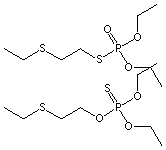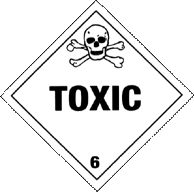Demeton
- Mercaptophos
- O,O-Diethyl 2-ethylmercaptoethyl thiophosphate
- Phosphorothioic acid O,O-diethyl o-(2-(ethylthio)ethyl) ester mixture with O,O-diethyl s-(2-(ethylthio)ethyl) phosphorothioate

Demeton | |
| |
| Formula | C8H19O3PS2 |
| Structure |  |
| Description | Oily liquid with an amber color and an odor of sulfur. |
| Uses | Acaricide, insecticide. |
| Registry Numbers and Inventories. | |
| CAS | 8065-48-3 |
| EC Index Number | 015-118-00-8 |
| RTECS | TF3150000 |
| RTECS class | Agricultural Chemical and Pesticide; Mutagen; Reproductive Effector; Human Data |
| UN (DOT) | 3018 |
| Merck | 12,2940 |
| Beilstein/Gmelin | 8474285 |
| EPA OPP | 57601 |
| Swiss Giftliste 1 | G-1480 |
| Properties. | |
| Formula | C8H19O3PS2 |
| Formula mass | 258.34 |
| Melting point, °C | -25.0 |
| Boiling point, °C | 134 |
| Vapor pressure, mmHg | 0.00026 (25 C) |
| Density | 1.183 g/cm3 (20 C) |
| Solubility in water | 100 mg/L |
| Hazards and Protection. | |
| Storage | Keep in well ventilated area. |
| Handling | All chemicals should be considered hazardous. Avoid direct physical contact. Use appropriate, approved safety equipment. Untrained individuals should not handle this chemical or its container. Handling should occur in a chemical fume hood. |
| Protection | Wear appropriate protective gloves, clothing and goggles. |
| Respirators | Wear positive pressure self-contained breathing apparatus (SCBA). |
| Small spills/leaks | Spills may be cleaned up by absorbing the material in vermiculite, dry sand, earth, or a similar material. General precautions for organophosphorous pesticides are as follows. Keep unnecessary people away; stay upwind. Shut off ignition sources; no flares, smoking, or flames in hazard area. Do not touch spilled material. Use water spray to reduce vapors. Take up spills with noncombustible absorbent material. For large spills, dike far ahead. |
| Stability | Stable. |
| Incompatibilities | Avoid contact with strong oxidizers, alkalis, water. |
| Decomposition | Toxic gases and vapors (such as sulfur dioxide, phosphoric acid mist and carbon monoxide) may be released when demeton decomposes. |
| Fire. | ||||
| Flash Point,°C | 45 | |||
| Autoignition, °C | 463 | |||
| Upper exp. limit, % | 5.3 | |||
| Lower exp. limit, % | 1 | |||
| Fire fighting | (Non-Specific -- Organophosphorus Pesticide, Flammable Liquid, n.o.s.) Wear positive pressure breathing apparatus and special protective clothing. Move containers from fire area. Dike fire control water for later disposal; do not scatter the material. Cool containers that are exposed to flames with water from the side until well after fire is out. Withdraw immediately in case of rising sound from venting safety device or any discoloration of tank due to fire. Isolate for 1/2 mile in all directions if tank car or truck is involved in fire.Use dry chemical, foam, carbon dioxide. Water may be ineffective | |||
| Fire potential | Combustible material: may burn but does not ignite readily. | |||
| Hazards | May release sulfur oxides and phosphoric acid. Solvent carrier vapors may travel on ground to ignition source. Avoid strong oxidizers. Avoid mixtures with water or polar solvents, in which sulfur is lost to oxygen, air and light, which cause hydrolysis, alkaline mixtures and oxidizing agents. | |||
| Combustion products | Irritating fumes of sulfur dioxide and phosphoric acid may form in fire. | |||
| Health. | |
| Exposure limit(s) | TLV: 0.01 ppm; 0.1 mg/m3 (skin) (ACGIH 1990-1991). OSHA PEL: TWA 0.1 mg/m3 skin NIOSH REL: TWA 0.1 mg/m3 skin NIOSH IDLH: 10 mg/m3 |
| Poison_Class | 1 |
| Exposure effects | Fever, low heart rate and abnormally low blood pressure, or rapid heart rate and elevated blood pressure may occur. Headache, dizziness, muscle spasms and profound weakness are common. Alterations of level of consciousness, anxiety, paralysis, seizures and coma may occur. Seizures may be more common in children. |
| Ingestion | Vomiting, diarrhea, fecal incontinence, pancreatitis and abdominal pain may occur. |
| Inhalation | Dyspnea, rales, bronchorrhea, or tachypnea may occur, with pulmonary edema in severe cases. |
| Skin | Sweating is a consistent but not universal sign. |
| Eyes | Constriction of the pupil, tearing, blurred vision and salivation are common. Prolonged dialation of the pupils may occur in severe poisonings. |
First aid |
|
| Ingestion | Seek medical assistance. |
| Inhalation | Move victim to fresh air. Apply artificial respiration if victim is not breathing. Do not use mouth-to-mouth method if victim ingested or inhaled the substance; induce artificial respiration with the aid of a pocket mask equipped with a one-way valve or other proper respiratory medical device. Administer oxygen if breathing is difficult. |
| Skin | Remove and isolate contaminated clothing and shoes. Immediately flush with running water for at least 20 minutes. For minor skin contact, avoid spreading material on unaffected skin. |
| Eyes | Immediately flush with running water for at least 20 minutes. |
| Transport. | ||
| UN number | 3018 |  |
| Response guide | 152 | |
| Hazard class | 6.1 | |
| Packing Group | I; II; III | |
| USCG CHRIS Code | DTN | |